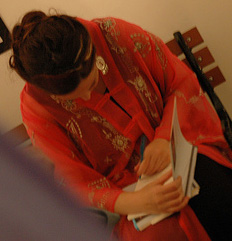Sankai Juku @ Hummingbird Centre



Sankai Juku doesn't just invoke a mood. The troupe's performances have the power to induce a state of mind and cast a spell over a packed auditorium.
Rattled urbanites attending Kagemi at the Hummingbird Centre last night went home a little looser at the neck and shoulders, breathing a little more gently and mentally carrying images of huge lotus blossoms suspended serenely in the air.
Artistic director Ushio Amagatsu and his six chalk-skinned dancers achieved something sublime with Kagemi (Beyond the Metaphors of Mirrors). Amagatsu was the soloist, a conductor of the forces of nature, at times reminiscent of an underwater god bringing harmony to his domain. At other times he resembled a storyteller, conjuring up a scene with only the eloquent movements of his arms and hands.
He set the pace for the seven-part show, slowly carving the air with his arms, moving them sideways to suggest the gentle lapping of waves and standing on a circular platform beside a bed of maybe 50 or 60 giant lotus blossoms, their stems dangling to the floor. Six forms, three bunched up and three stretched out, lay beneath them. The flowers ascended on invisible strings to form a canopy, the individual blooms turning ever so slightly in the air. The white-rice dust that covers the dancers head to toe tends to obliterate personality in the Sankai Juku ranks. From Semimaru, who has been with the company since its beginning in 1975, to Ichiro Hasegawa, who joined two years ago, we know them only by the shape of their skulls. But in Kagemi, Amagatsu gives them a degree of individuality and, by allowing them to interact, nudges the dance towards a vision of a common humanity with tribal demarcations.
Raised arms and open hands made a constant motif. The fingers were outstretched, curled to form flower shapes or wiggling like antennae. Three bare-chested figures in loincloths and sashes moved up and down, in a forward kneeling movement. Three stood tall in long skirts that kissed the floor as they proceeded in formation. The gestures were like semaphore or hieroglyphics, repeated and reflected as the dancers faced each other. The image, the mirror and the reflection might all have been separate entities as they gathered, then parted and went their separate ways.
Occasionally a dancer opened his mouth wide, making the universal shape of the "a" sound, a round black hole in the middle of the face. It is as dramatic as Kagemi gets, yet it's moving. The music ranged from a thundering percussive piece, done on big skin drums, to a slightly melancholy piano solo and a piece of Japanese music for a stringed instrument.
In a scene where four dancers emerge in long gowns that appear to be covered in volcanic ash, the music is a raging storm of heavy-metal rock. The dancers are suddenly touching, silently laughing and grinning as they fingerpaint each other in streaks of red or black across the cheek or forehead. The final scene, in which six dancers reappear in creamy robes with ribbed overlays that look like the skeletons of fish, features more ritualistic movement. The dancers form a circle, opposition disappears and as they rise and fall in unison, they seem to be offering a promise of, or at least a wish for, peace.


0 Comments:
Post a Comment
<< Home